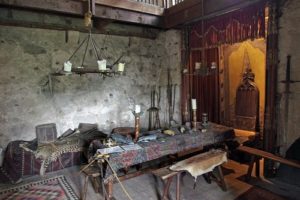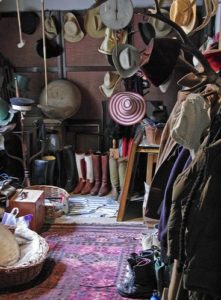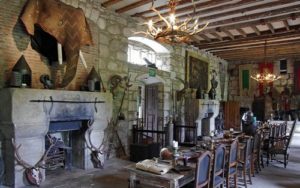I’ve been wanting to visit here for years. When we were in Durham in the sixties, it was a roofless shell and not open to the public. Now it has a new owner and is slowly being restored and is loved again.
If you are expecting the usual stately home filled with beautiful furniture then you will be very disappointed. Imagine your garage and loft full of clutter and multiply by the number of rooms in the castle and you begin to get an image of what it is like. It is a repository for family belongings and memorabilia collected over the years. There is everything from Tibetan prayer horns to giant elk antlers. Throw in old shoes, spinning wheel, armour, chinese temple lions, stuffed birds plus other objects too many to mention and you begin to get an idea. It is definitely different and you need a sense of humour to appreciate it. We were delighted to find that we were allowed to take photos in the castle. The room stewards are excellent and have a wealth of stories about the castle.
The Minstrel's tea room is pretty good too…. We enjoyed our visit.
The castle began as a 12thC tower house. The original tower is to the left of the entrance. It was given a licence to crenellate in 1344 (which is still preserved in the castle) when it was extended to four towers joined by walls around a central courtyard with a moat round the outside.
After the Union of the Crowns in 1603, the moat was filled in and battlements converted into more comfortable residential wings, probably to welcome James VI of Scotland on his way south to be crowned King James I of England. The grounds were landscaped in 18th & 19thC.
The castle used by the military during WW2 and wood from the ceilings, panelling and floors was stripped out and burnt by Canadian airmen billeted there. After the war, the house was left derelict and the lead removed from the roof and sold.
In the 1980s, the estate was bought by Sir Humphrey Wakefield and his wife Katherine who is a distant relation of the Grey family who had previously owned Chillingham. They have begun the slow and painstaking task of restoring the castle. They live in the west wing and their eldest son and heir has apartments in the south east tower. It would seem that Chillingham is once more in safe hands.
The castle is a mixture of medieval chambers and Jacobean staterooms.
Through the main entrance is the ticket office with the armoury and still room and dungeon beyond. Our first port of call was the Minstrel’s tea room in the old medieval kitchens with its welcoming fire in one of the old fireplaces and excellent cakes. Down here in the depths, in an old cellar, is the Berthele Room. This is a collection of prehistoric artefacts especially flint and stone tools collected locally by FM Berthele between 1960-90 when he was working for the Forestry Commission.
Next to it, another cellar is set up as a torture chamber. The real one was sealed off by Sir Humphrey as he felt it was wrong to turn all its misery and cruelty into an attraction for gawping tourists. Among other things, it includes a blacksmith’s forge, an illegal still, rack, iron cage, spiked chair, instruments of torture and an iron maiden specially made for a film about Elizabeth I.
A flight of stairs off the cobbled courtyard lead up into the Great Hall, with two stone replicas of Easter Island statues by the door. This is an apt setting for what is inside… It is an Elizabethan chamber with stone flagged floor and beamed ceiling. On the walls are tapestries, standards, armour, weapons and shields as well as ibex heads with antlers. The chandelier is decorated with more antlers. There are two large stone fire places, one with elephant head armour above it.
In the centre is a large table with part of a suit of Indian armour. Don’t be deceived, they are not drinking horns on the table but Tibetan prayer horns. There is a knight in a suit of armour on a horse are two wooden Chinese temple lions which have seen better days… (Have I said that the castle is decidedly quirky?)
In a corner, stairs lined with boots, walking sticks and dog collars lead past a store room full of more boots, hats and clothes to a bedroom. As well as the normal bedroom furniture there is a cage full of stuffed birds and every available space on the walls is covered with old prints.
The stairs continue to the roof with lovely views down onto the formal garden with carefully trimmed low box hedges, taller yew hedges with topiary, stone urns rose bushes and cat nip.
Next is Edward I Room which is the oldest part of the castle. At the top of a tower it would have been well away from the stench of the moat. This was used by the family unless there was a royal visit. Henry III slept here in 1255 and Edward I on his way to the battle of Falkirk in 1298, where he captured William Wallace. The window overlooking the gardens was installed for his visit. The room has been restored to its 13th century format with a gallery, armour, weapons and furnishings of its time, including a wooden ‘throne’ in a curtained alcove. On display is the “License to crenellate”, or Royal permission to build battlements, issued in 1344 and is the only license still in its castle of origin.
Above the Great Hall is a suite of three state rooms built specially for the visit of James VI on his way south to be crowned James I of England. These have been completely restored as the ceilings had fallen in. Part of the original ceiling of the James I Room was found under the oriel window and this was used as the blue print for a completely new ceiling. It is beautiful with a pattern of grey and gilt ribs on a beige background with gilt flower and leaf motifs and hanging bosses. The wall coverings and curtains are gold silk damask with pink roses. This was originally woven for Chatsworth house but had a flaw and was rejected. The white and gilt fire place houses a coal effect gas fire behind a gilt frame fire screen. Round it are armchairs and a sofa. The room is furnished with 18thC reproduction furniture and is probably the most ‘normal’ room in the house. There is a bureau bookcase, card table, spinnet, gilt leg table with a marble top with a mirror above. There is a small table inlaid with mother of pearl, knee hole desk, harp and a wooden bath allegedly belonging to Marie Antoinette…Every available space is filled with clocks, pictures, china, family memorabilia. On the window ledges are Chinese blue and white flower jugs and small painted porcelain dogs.
The Grey Armourial Room or Plaque Room Library has the 16thC armourial plaque of the Grey family above the fireplace. This was found in pieces in the courtyard, reassembled and lifted through the window. One wall is covered with a wooden cupboard with Egyptian style legs which is full of books. There are large oil paintings of the Chillingham wild cattle on the walls. Now furnished as a cosy sitting room, this would originally have contained a four poster bed where the King would receive close family and friends.
This leads into the New Dining Room. This was originally the room where the King slept and washed. The royal garderobe was inserted into the shaft of the spiral staircase in the walls. It is now replaced by an old fashioned WC. The stone walls have a series of paintings from Peru. In the centre is a long table laid with plates, large silver plate wine cooler, candlesticks and serviettes with a black embroidered bat, the emblem of the Wakefield family. There are large screens, tapestry covered chairs, a small statue of St Michael killing Satan….
Of the state rooms is the Museum with part of a clock mechanism ticking slowly. This is an eclectic collection – bird’s eggs, a teddy bear, dress suits, ladies dresses, baby walker, bath chair, magazines, rocking horses, dolls prams, saddles, treadle sewing machine, a sledge used by Sir Humphrey’s great uncle on his expedition to Everest with Mallory and Irving in 1922. It is a hotch potch collection of family memorabilia collected over many years and rather thrown in here with little attempt to display or label.
Reached from the museum is the Chapel which is off the Great Hall. It had been panelled over in the 16thC when private chapels were regarded as suspect and used as a library. It was only rediscovered when the woodwork was stripped out during the war to be used as firewood. It has been restored as a chapel and family services are held here again. It contains a small stone font and has a small chancel with a piscina.
A spiral staircase leads to the gallery above the tea room.
We didn’t visit the dungeon or still room with its model of the witch of Chillingham. This was a real person who was invited to Chillingham to exorcise the ghosts but left a curse on all who steal from Chillingham. There are letters of remorse from those who tried and then experienced bad luck.
The gardens are reached through the shop. To the south of the house are lawns with a pond with four herons at the corners. The formal gardens with box and yew hedges, topiary and urns are to the west of the house.
About 5 minutes walk from the castle is St Peter’s Church, also worth a visit.
The car park is just off the road and it is about half a mile walk to the castle. Disabled parking is allowed nearer the house.
The wild white cattle of Chillingham which roam free in the park can only be visited on a guided walk with a warden, lasting about an hour. The herd is descended from the prehistoric wild oxen. It is thought they were trapped here when the estate was walled in the early 13thC. They haven’t been handled since medieval times and are truly wild. In fact the herd will kill any animal who has been handled. Regretfully, we weren’t able to do the tour this time – another time maybe…..
Chillingham is a decidedly quirky castle. We enjoyed our visit and were glad to have been. It is the kind of place everyone ought to visit once and the tea room more than once!










